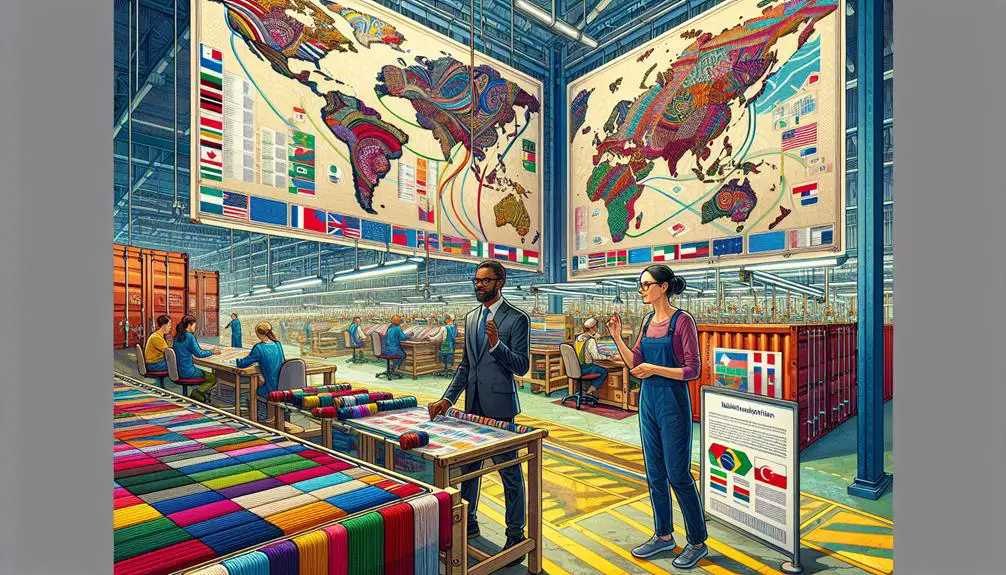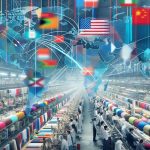Imagine a world where every thread and fabric in the textile industry is controlled by an intricate web of trade policies. You might think it's a bit dramatic, but tariffs, quotas, and trade agreements truly dictate the ebb and flow of textile markets. When you understand how tariffs impact costs and how quotas limit market access, it becomes clear that these policies are more than just political tools—they're business catalysts. Delve into how trade agreements foster global partnerships and how subsidies can give companies the competitive edge they need. Curious about how all this shapes your strategy? Let's explore further.
Table of Contents
Key Takeaways
- Tariffs: Tariffs increase consumer prices and reduce product variety, protecting domestic industries from foreign competition.
- Quotas: Quotas limit imported textile volumes, affecting market competition and restricting new market entrants.
- Trade Agreements: Trade agreements adjust tariff rates, influencing costs, competitiveness, and market access for textile products.
- Subsidies: Government subsidies and incentives lower operational costs, fostering industry growth and technological advancements.
- Supply Chain Dynamics: Trade policies impact sourcing strategies, production costs, and logistics, necessitating agile and informed supply chain management.
Tariffs and Their Impact
Tariffs can greatly impact the cost of textile products, altering both consumer prices and industry profitability. When you explore the field of trade negotiations, you'll discover that tariffs play a significant role in shaping economic growth. By imposing tariffs, governments aim to protect domestic industries from foreign competition. However, these import restrictions can also lead to increased prices for consumers and reduced variety of products available in the market.
Understanding how tariffs impact market competition is vital. High tariffs on imported textiles can limit market competition, allowing domestic producers to dominate. This can lead to inefficiencies and complacency within the domestic industry since there's less pressure to innovate or improve quality.
Conversely, lower tariffs may foster a more dynamic market, driving domestic companies to enhance their products and processes to stay competitive.
For those aspiring to master the complexities of tariffs, it's crucial to recognize their dual-edged nature. While they can stimulate economic growth by safeguarding local jobs and businesses, they can also stifle competition and lead to higher consumer prices. Balancing these effects during trade negotiations is essential to achieving a favorable outcome for all stakeholders involved.
Quotas and Market Access
In addition to tariffs, quotas play a significant role in shaping the landscape of market access within the textile industry. Quotas set a limit on the volume of textiles that can be imported from specific countries, thereby influencing market competition and controlling import restrictions. By imposing quotas, governments aim to protect domestic industries from being overwhelmed by foreign products, which can sometimes lead to a more balanced market environment.
However, quotas can also create substantial trade barriers, making market entry difficult for new players. As an industry expert, you need to understand how these limitations affect your strategic planning and operational efficiency. Consider the following key points:
- Supply Chain Management: Quotas can disrupt your access to raw materials or finished goods, requiring you to seek alternative suppliers.
- Pricing Strategies: Limited market entry can drive up prices, affecting your pricing models and profitability.
- Market Diversification: You may need to diversify your markets to mitigate the impact of quotas, ensuring a more resilient business model.
Navigating these complexities requires a keen understanding of both local and international trade policies. Mastering the nuances of quotas and market access will empower you to stay competitive and adaptive in the ever-evolving textile industry.
Trade Agreements
You'll see how trade agreements shape the textile industry by examining tariff impacts on imports, export incentives, and regional trade blocs.
These agreements can lower costs or create new opportunities for your business.
Understanding their influence is essential for strategic planning in the global market.
Tariff Impacts on Imports
Trade agreements often directly influence the costs of textile imports through the implementation of tariffs. When tariffs are imposed, import costs rise, making foreign textiles more expensive. This increase can stifle market competition, as domestic producers may not face the same level of price pressure from international competitors. Consequently, this can lead to higher prices for consumers and potentially reduced choices in the market.
To understand the impact of tariffs, consider the following points:
- Increased Import Costs: Tariffs raise the price of imported textiles, directly affecting the overall cost structure for businesses relying on these goods.
- Reduced Market Competition: Higher tariffs can decrease the competitive pressure on domestic industries, allowing them to maintain or increase prices without fear of being undercut by cheaper imports.
- Trade Restrictions: These barriers can hinder industry growth by limiting access to diverse materials and innovative products from global markets.
Export Incentives and Benefits
While tariffs impact imports, export incentives in trade agreements can provide substantial benefits to the textile industry by opening new markets and reducing costs. As a professional in the textile industry, you know how crucial it's to seize these opportunities.
Export incentives like tax rebates and subsidies markedly lower your operational expenses, making your products more competitive on the global stage.
Trade agreements often include provisions for government support, which can take various forms, such as financial assistance for upgrading technology or improving infrastructure. By leveraging this support, you can enhance your production capabilities and meet international quality standards more efficiently. This, in turn, makes your products more attractive to foreign buyers.
Trade promotions are another vital aspect of these agreements. These promotions frequently involve marketing campaigns and trade fairs sponsored by the government, helping you showcase your textiles to a broader audience. By participating in these initiatives, you can establish valuable connections and gain insights into consumer preferences in different markets.
In essence, export incentives and benefits embedded in trade agreements empower you to expand your market reach, boost your competitiveness, and ultimately, drive growth in the textile industry.
Regional Trade Blocs Influence
In the textile industry, regional trade blocs can greatly shape your business strategies by creating unified markets and streamlining trade regulations. These blocs, such as NAFTA or the EU, aim to eliminate trade barriers and foster closer economic ties among member countries. As a result, you can enjoy significant benefits like supply chain efficiencies and better market integration.
When you operate within a trade bloc, regional market access becomes much smoother. You don't have to navigate a web of tariffs and quotas, making it easier to expand your business across borders. Additionally, the harmonization of standards and regulations simplifies compliance and reduces costs.
Consider these key advantages of trade blocs:
- Supply Chain Efficiencies: Streamlined processes and reduced barriers mean faster, more reliable supply chains.
- Market Integration: Seamless access to a larger, unified market allows you to scale operations more effectively.
- Trade Bloc Benefits: Enjoy reduced tariffs, fewer regulatory hurdles, and enhanced cooperation among member countries.
Subsidies and Incentives
Governments worldwide often provide subsidies and incentives to bolster their domestic textile industries. You'll see that government support comes in various forms, such as direct financial aid, tax breaks, and low-interest loans. These measures are designed to stimulate industry growth, making it easier for local textile businesses to innovate, expand, and remain competitive.
By injecting capital directly into the textile sector, governments enable companies to invest in advanced technologies and modernize their production processes. This not only enhances efficiency but also helps in meeting international standards, thereby improving the quality of the products.
Tax breaks reduce the financial burden on textile companies, allowing them to allocate more resources to research and development, marketing, and expansion efforts.
Low-interest loans provide the necessary liquidity for businesses to scale operations without the overwhelming weight of high-interest debt. This financial breathing room can be pivotal in transforming small-scale operations into large, thriving enterprises.
As a result, you'll find that these forms of support significantly contribute to a robust and resilient textile industry, capable of adapting to market fluctuations and emerging trends.
Understanding these mechanisms empowers you to appreciate how strategic government support can drive substantial industry growth and innovation.
Industry Competitiveness
A competitive textile industry thrives on innovation, efficiency, and adaptability. To stay ahead in the face of global competition, you must continually innovate, streamline operations, and swiftly adapt to changing market demands. Being competitive means leveraging advanced technologies and sustainable practices to reduce costs and improve product quality.
Trade policies play an essential role in shaping your industry's competitiveness. They can either open up new markets or impose barriers that limit your reach. To succeed, you need to understand and navigate these policies effectively.
Consider focusing on:
- Research and Development: Invest in R&D to develop new materials and processes that can give you a unique edge.
- Quality and Efficiency: Implement lean manufacturing techniques to reduce waste and enhance product quality.
- Market Intelligence: Stay informed about global trends and consumer preferences to anticipate shifts in market demand.
Supply Chain Dynamics
Your textile business's success hinges on an efficient and resilient supply chain. To master the complexities of supply chain dynamics, you need to focus on global sourcing. By diversifying your suppliers across different regions, you mitigate risks like political instability or natural disasters that could disrupt your supply chain.
Global sourcing isn't just about finding the most important materials; it's about balancing quality, reliability, and cost.
A well-optimized supply chain can greatly reduce your production costs. When you streamline logistics and establish strong relationships with suppliers, you cut down on delays and inefficiencies. This allows your business to be more agile and responsive to market demands.
Additionally, leveraging technology such as supply chain management software can give you real-time insights into inventory levels, shipment statuses, and potential bottlenecks.
Trade policies play a vital role in shaping your supply chain dynamics. Tariffs, import quotas, and trade agreements can all impact your sourcing strategy and production costs. Staying updated on policy changes ensures you can pivot quickly to maintain your competitive edge.
Essentially, a strategic approach to supply chain management, informed by current trade policies, will drive your textile business toward sustained success.
Frequently Asked Questions
How Does Consumer Demand Influence the Textile Industry?
Imagine you're a puppet master; consumer demand pulls the strings. Your supply chain dances, adapting through market analysis. Demand surges, and the textile industry's threads weave faster, crafting trends and innovations to captivate discerning buyers.
What Are the Environmental Impacts of the Textile Industry?
You should understand that the textile industry has a profound impact on the environment through water pollution and poor waste management. Additionally, high carbon emissions challenge sustainability efforts, demanding more innovative solutions and responsible practices for meaningful change.
How Has Technology Changed Textile Manufacturing Processes?
Imagine weaving magic with automation advancements and digital design processes. You've turned textile manufacturing into a symphony of precision and efficiency, revolutionizing production speed, reducing errors, and elevating your craft to new heights.
What Role Do Labor Laws Play in the Textile Industry?
Labor regulations safeguard worker rights by mandating fair wages, safe conditions, and reasonable hours. You'll find that robust labor laws enhance productivity and morale, ultimately benefiting both workers and the overall success of the textile industry.
How Do Fashion Trends Affect Textile Production and Sales?
Fashion trends directly impact your market influences, driving changes in production strategies. When trends shift, you must adapt quickly to meet demand, ensuring your textile production aligns with what's currently popular and profitable.
- The Use of Nonwovens in Construction and Civil Engineering - July 11, 2025
- The Use of Nonwovens in Construction and Civil Engineering - July 11, 2025
- The Use of Nonwovens in Construction and Civil Engineering - July 11, 2025







